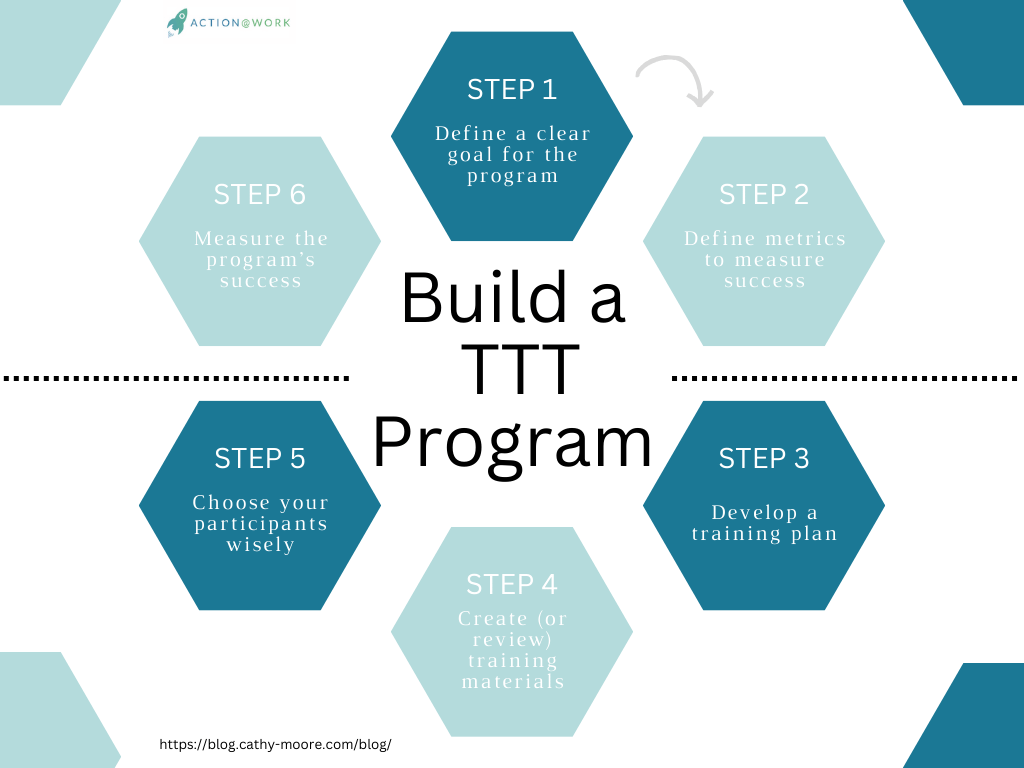Train the trainer is a principle that started in NGOs to improve training quality on a limited budget. The approach involves having a SME (internal or external) hold a training session for the current or potential trainers in your company. Keep reading to discover:
- What is Train the Trainer (TTT) and how it applies to modern L&D?
- The benefits of Train the Trainer
- How to build a TTT program in your organization
What is Train the Trainer?
Work in L&D? Got huge training demands to fulfill but not enough resources? Looking for ways to squeeze the most out of your training budget? You’ve come to the right place.
Employees want continuous training, we know this. But most L&D teams simply don’t have the budget or resources to meet their demands.
If only there were a way to build a larger pool of competent trainers so you could extend your training budget, meet employees’ demands, and get the best ROI. Oh, and improve the quality of current trainers at the same time.
We have good news for you, there is a way. It’s called the Train the Trainer model.
This principle was first applied by NGOs in a bid to increase training on a tight budget. And thanks to its success, it’s become a popular tactic for organizations of all shapes and sizes.
During the Train the Trainer session, your trainers will learn about the subject matter and how to facilitate training on this topic. That way, they can apply this knowledge and hold further training for employees across your organization.
This approach enables you to improve the skills of your trainers, upskill new trainers, and ensure that more staff have access to employee education.
During the session, your staff will learn the following from a qualified SME:
- Instructional techniques and styles
- Presentation skills
- Communication strategies
- Facilitation tactics
- Feedback skills
- Assessment tips
At the same time, they’ll deepen their knowledge of the topic you’re covering.
Following the TTT program, they’ll have the skills to train others on the subject and offer more engaging and effective sessions.
Now let’s take a look at how the TTT model can benefit your business.
Main benefits of the Train the Trainer model
You’re busy. Trying to implement a new training model is probably the last thing you need right now. But it could be a worthwhile investment that saves you time and money down the line.
Here are seven benefits of including the TTT principle in your training strategy:
- You can turn staff members into internal SMEs by upskilling and reskilling them.
- It’s a cost-effective approach that utilizes internal expertise instead of hiring external SMEs.
- You can provide personalized training sessions that are tailored to your specific organizational structure, goals, and needs.
- It’s a scalable and accessible training model – once employees receive the training, they can pass it on to other staff members.
- Trainees can apply the newly acquired knowledge straight away (avoiding the notorious forgetting curve).
- There’s also more scope for follow-ups if participants need further post-training support.
- It enhances knowledge management by preventing key information from leaving the company if an experienced employee leaves.
- Provides better consistency across training initiatives as all trainers follow the same approach.
- You can provide high-quality training to a wider pool of employees without significant costs.
How to build a Train the Trainer program in six steps
Launching any training program takes time and resources, this is no different. Where the big difference lies is in the payoff.
Once your TTT course is up and running, you’ve created a bunch of experts who can go forth and keep the learning streak alive. So, it’s an investment that can pay off for years to come.
Here’s how to set your program up in six steps:

Step 1: Define a clear goal
Just like any other training initiative, you’ll need to start by setting a clear goal for the Train the Trainer program.
This goal should align with organizational objectives and should contribute to solving a current performance issue or creating a behavior change.
That way, you have tangible metrics when it comes to measuring the effectiveness of the training.
In some cases, the goal could be to transfer knowledge from experienced staff to junior employees. Or create an army of internal change agents in the company.
Whatever your big goal is, make sure it’s clear and measurable.
Step 2: Define metrics
We all know too well the importance of calculating ROI and training impact. Good feedback alone usually isn’t enough for the powers that be. They also want to see numbers. Or, more accurately, they want data to confirm that it’s actually working.
Setting clear metrics at the beginning makes it easier to measure the impact of the program. For instance, you may want to monitor feedback from both participants and trainers. When possible, try to link these metrics to performance KPIs.
How is the training improving employees’ on-the-job performance? Are employee engagement levels higher? Have staff turnover rates fallen?
Of course, some of these are long-term metrics, but they should still be defined early doors.
Step 3: Develop a training plan
This step will vary depending on who will run your TTT program. For instance, if you’re inviting an external SME or TTT course provider, then this part will largely be done for you. You may just want to tweak it to tailor it to your business and employees’ situation.
On the other hand, if an internal expert will host the session, then you’ll need to design a training plan for it.
Your training plan includes all the essential information that you want participants to cover during the session.
Typically, L&D or training teams will work closely with the SME to determine what learners need to know and what they can cut.
This is where you’ll offer any suggestions on how to improve the plan or align it more closely with business goals. For example, relevant instructional design models or theories.
It’s important to remember that the Train the Trainer model teaches training delivery skills and the subject matter at the same time. So, you need to ensure that the plan covers the essentials for both.
You’ll also need to allocate time in the plan to work on adult learning principles, group faciliation techniques, and training delivery best practices.
If not, you could end up with some very well-informed employees who aren’t ready to train others.
Step 4: Create training materials
If you’re going the in-house route, the next step is to transform the training plan into a series of engaging learning content.
This could include practice scenarios, videos, job aids, case studies, and assessments. It should also feature detailed training facilitation plans and any handouts you may need.
One of the benefits of this principle is that it encourages consistent training. Keep that in mind when creating the training materials. They should be homogeneous and accessible to all future trainers.
Step 5: Carefully select your audience
The big question remains: Who are you going to invite to attend the first Train the Trainer course? Your choice of guestlist here could actually have a pretty big impact on the ongoing success of the program. So, choose wisely.
Here’s an overview of what makes a good candidate.
The right employee should be:
- Well-respected and known in the organization
- A strong communicator and public speaker
- Experienced in the subject matter
- Willing and able to dedicate time to delivering the training
Step 6: Measure the program’s success
Your program is launched. Before you put your feet up and pat yourself on the back, there’s one more step. It’s time to measure how successful it was.
To do this, you need to first circle back to the success metrics you established in step two. What factors will you measure to determine if the program met your goals? How will you collect that data?
There are several ways to get the answers you need. Learner feedback, trainer interviews, and LMS reports (if you’re holding the training online) can give you deep insight into how the program performs.
And, as we mentioned earlier, comparing relevant performance metrics from before and after the initiative.
This data is a great starting point for iterating, tweaking, and continuously refining the TTT course.
Next steps
As training professionals, we’re often tasked with the impossible. More training, less budget.
Train the Trainer is a good tool to have in your arsenal when your list of training demands starts to creep up. It’s a sustainable model that can help you deepen employees’ skills and create more training opportunities in your organization with limited resources.
The result is a more skilled and satisfied workforce and one less thing on your plate.
And if there’s one thing we know as L&D pros, it’s that teaching is the best way to learn something.
Get more insights into instructional design and corporate training on the blog.

By Nicola Wylie
Nicola Wylie is a learning industry expert who loves sharing in-depth insights into the latest trends, challenges, and technologies.
